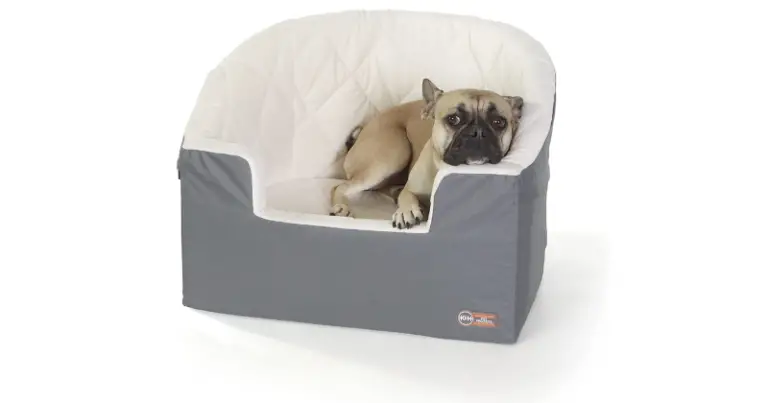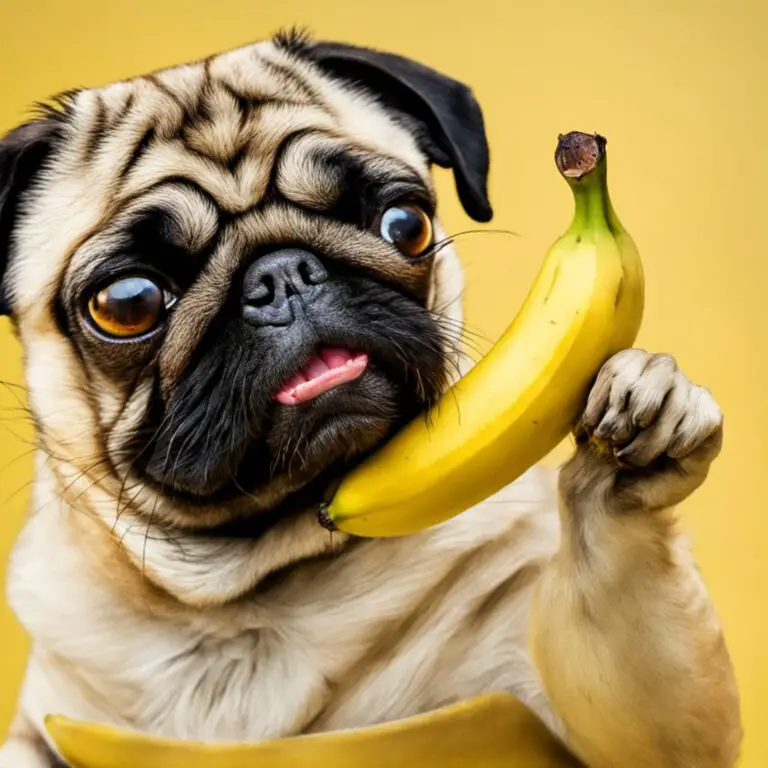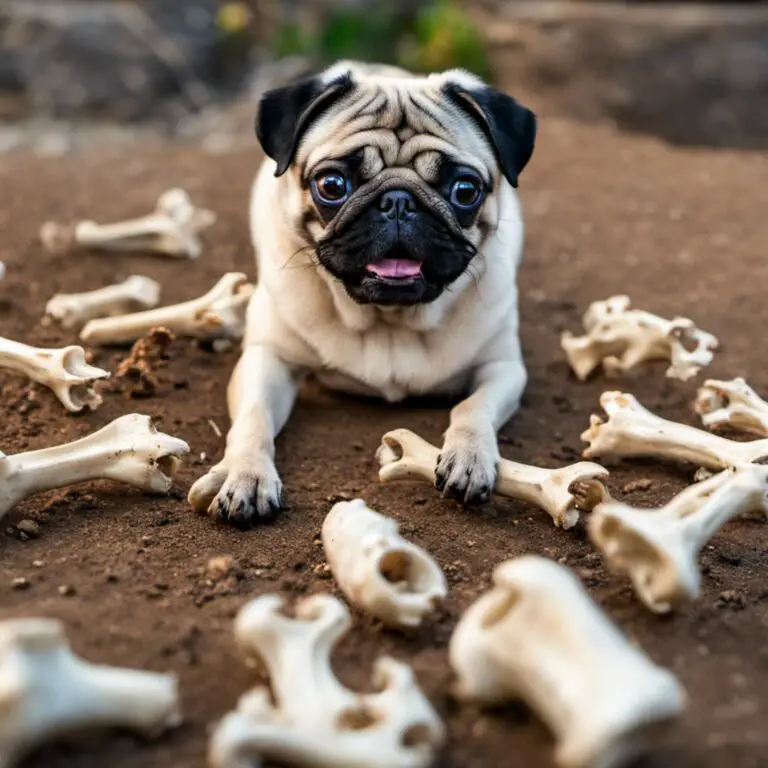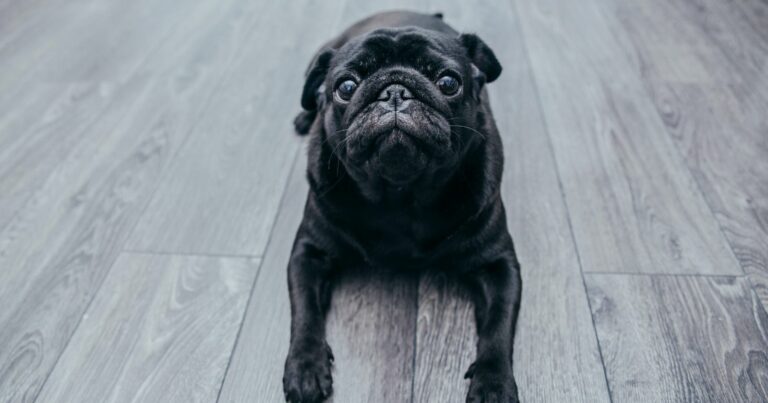Can Pugs Eat Pizza? Debunking Myths and Exploring Facts
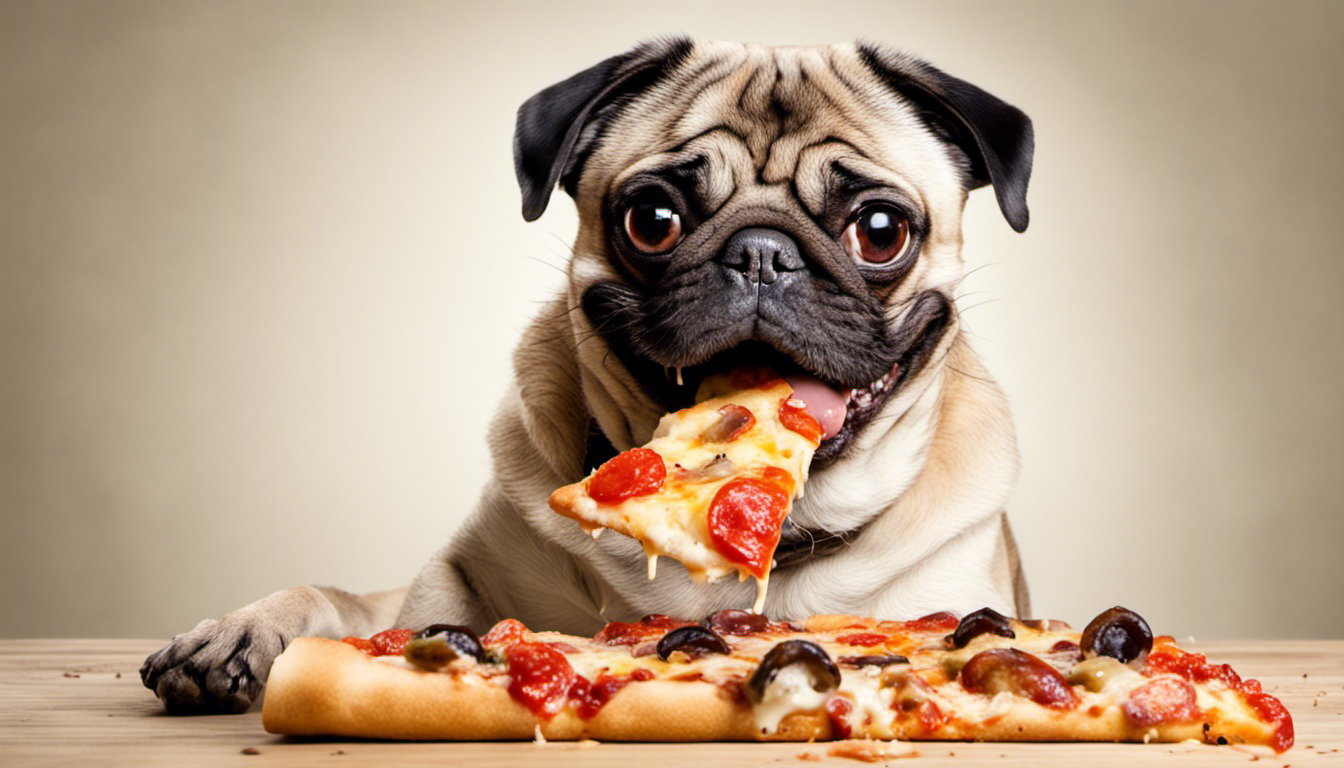
Pizza is a popular food many people enjoy, but can pugs eat pizza? As a pug owner, you might be worried about giving your furry friend a slice as a treat. This article explores the potential risks and concerns associated with pugs consuming pizza.
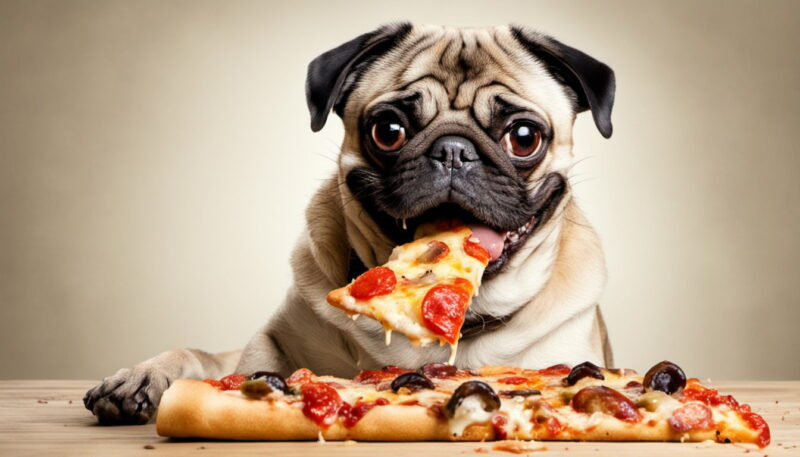
Although pizza might seem harmless to share with your pet, it contains ingredients that can harm pugs. Ingredients such as sauce, cheese, garlic, and pepperoni found in most pizzas can be toxic to your pooch. Some pizza sauces may be okay for dogs, while others can be potentially toxic due to high salt content and the addition of garlic spices.
It’s important to be cautious when feeding your pug human food, as some ingredients may not suit their unique dietary needs. Keeping your pug’s diet in mind will help ensure their health and happiness, providing them with the appropriate nutrition for their breed and size.
Contents
Table of Contents
Can Pugs Eat Pizza?
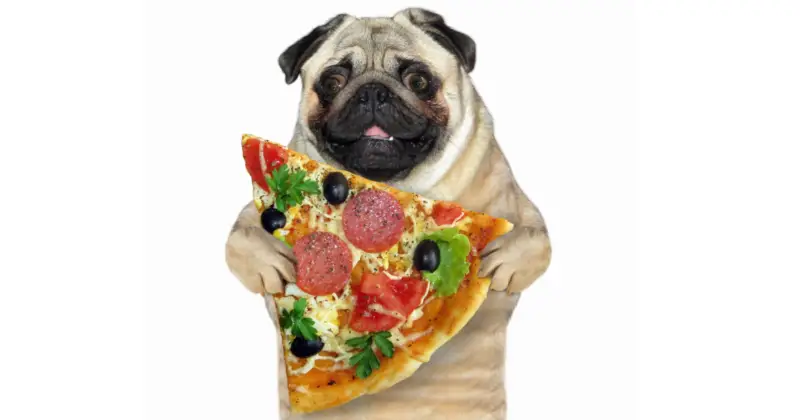
As a pug owner, you might wonder if sharing your pizza with your furry friend is safe. The short answer is no, pugs should not eat pizza. Pizza contains ingredients that can be harmful or even toxic to your pug.
Get The Free Food Eating Guide That Keeps My Pug Happy and Playful Even at 13 Years Old
100% Beginner Friendly & Lists Real Foods Your Pug Can Actually Eat!
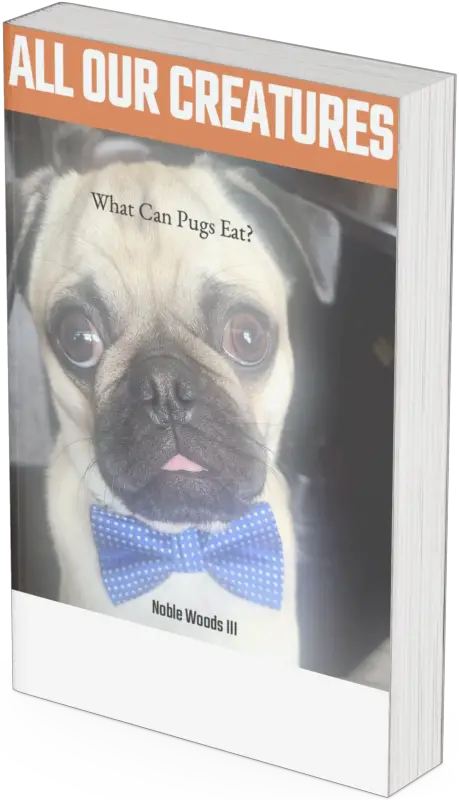
Firstly, the pizza sauce might pose a risk to your pug. Some pizza sauces are fine for dogs, while others contain high levels of salt and additives like garlic, which can be toxic to pugs. It’s best to avoid feeding your pug any pizza sauce, as you can’t always be certain about the ingredients.
Another reason to avoid giving pizza to your pug is the presence of potentially harmful toppings. Common pizza toppings like pepperoni, onions, and garlic can pose serious health risks to your pug. These ingredients can cause gastrointestinal issues, anemia, or even organ damage.
Cheese, a basic ingredient of most pizzas, is also not ideal for pugs. Some pugs are lactose intolerant, meaning consuming cheese can lead to digestive problems such as diarrhea or vomiting. While small amounts of cheese might not cause severe issues, avoiding giving it to your pug is better.
The pizza crust is another concern for pug owners. While it might not be toxic, it is typically high in calories and provides little nutritional value. Feeding your pug pizza crust can lead to weight gain and obesity, further exacerbating existing health issues common to the breed.
In conclusion, it is best to avoid giving pizza to your pug altogether. There are many dog-friendly treats and snacks available that are healthier options for your pug. Remember, providing your pug with a balanced diet is essential to ensure they can live a happy and healthy life.
Pizza Ingredients and Their Effects on Pugs

When it comes to pizza ingredients, some of them can be toxic and harmful to your pug. Here’s a rundown of common pizza ingredients and how they may affect your furry friend.
Cheese and lactose: Although some dogs can tolerate cheese in small amounts, pugs with lactose intolerance should avoid it. Excessive consumption of cheese can lead to stomach upset. Consider using lactose-free cheese alternatives if you’re making a homemade pizza for your pug.
Meat toppings: Meats such as pepperoni, sausage, and seasoned chicken might be tempting for your pug, but the high salt content and spices can harm their health. Alternatively, opt for plain, cooked meats when preparing a dog-friendly pizza.
Onions and garlic: Both onions and garlic are toxic to dogs and should never be included in their diet. If consumed, these ingredients can cause anemia and damage your pug’s red blood cells.
Tomato sauce: Ripe tomatoes are generally safe for dogs in small amounts. However, green tomatoes, leaves, stems, and tomato sauce that contain garlic, onions, or spices can be hazardous to your pug.
Pizza crust: The pizza crust may contain ingredients that are dangerous to your pug, such as onions or garlic. Additionally, sugar in the crust can lead to obesity and health issues when consumed regularly.
Salt and spices: Excessive salt intake is unhealthy for dogs and can lead to dehydration and even sodium poisoning. Spices, especially those containing onion or garlic powder, should also be avoided.
Safe toppings: When making a pizza for your pug, consider using toppings like cooked carrots, mushrooms, and pineapple. These ingredients are generally safe and can provide additional nutrients to your pug’s diet.
In summary, it is best to avoid feeding your pug regular pizza due to its potentially harmful ingredients. However, you can still create a dog-friendly pizza using safe alternatives such as lactose-free cheese, plain cooked meats, and dog-safe veggies. Remember to be cautious with ingredients like ripe tomatoes, salt, and spices, and always exclude toxic ingredients such as onions, garlic, and green tomato from your pug’s diet.
The Nutritional Aspect of Pizza and Dog Food

Regarding your pug’s diet, it’s essential to understand the nutritional differences between pizza and dog food. While you may enjoy a slice of pizza, it’s important to consider whether it’s a safe and nutritious option for your furry friend.
First, let’s examine the nutritional value of pizza. Typically, it is high in calories, carbohydrates, and cholesterol, with a varying amount of protein depending on the toppings. Although these factors may be acceptable in moderation for humans, they may pose significant health risks for your pug. Over time, a high-calorie diet can contribute to obesity, and excessive carbohydrates can lead to issues such as diabetes and pancreatitis.
In contrast, dog food is specifically designed to meet the nutritional needs of your pug. High-quality dog food provides a balanced diet, including the right amount of protein, carbohydrates, and essential nutrients. It is also formulated to support your pug’s overall health, ensuring their bodily functions and immune system operate effectively.
Furthermore, certain pizza ingredients, such as onions, garlic, and mushrooms, can harm dogs. Even tomato sauce, a common pizza base, may contain ingredients that are potentially harmful. These factors further emphasize the importance of maintaining a consistent diet of safe, nutritious dog food for your pug.
In conclusion, while pizza may be a delicious treat for you, it’s essential to remember that your pug’s dietary needs differ significantly. You’ll contribute to their long-term health and well-being by feeding your pug high-quality dog food, ensuring a happy and healthy life.
Possible Health Risks of Feeding Pizza to Pugs

Feeding pizza to your pug may result in various potential health issues. One of the primary concerns is the risk of obesity. Due to the high fat and sodium content in pizza, regular consumption may cause your pug to become overweight or obese. This can lead to many health problems, such as heart disease and diabetes1.
Additionally, many pizza ingredients can harm your pug’s digestive system. For example, if your pug is lactose intolerant, consuming pizza with cheese can cause gastrointestinal issues, leading to vomiting, diarrhea, and dehydration. Some pizza toppings, such as garlic and onions, can even cause poisoning and anemia in dogs2. It’s essential to be aware of these risks before considering pizza as a treat for your pug.
Another concern is bloat, a serious health issue that can occur if a dog consumes too much food too quickly. Bloat can be life-threatening and requires immediate attention from a veterinarian3. You may increase the risk of bloat by feeding your pug pizza, which is often high in carbohydrates and difficult to digest.
Lastly, the high sodium content found in pizza may lead to increased thirst and potentially dehydration for your pug. Consuming excessive sodium can also exacerbate existing medical conditions or contribute to developing heart disease4.
In summary, feeding pizza to your pug poses several possible health risks, including obesity, digestive issues, and poisoning. To prevent these problems and maintain your pug’s health, avoid sharing pizza and choose canine-friendly treats.
Can Pugs Eat Pizza? Watch this
Healthier Alternatives to Pizza for Pugs
Instead of sharing a slice of pizza with your pug, consider offering them some healthier treats that will nourish their bodies and satisfy their taste buds. Countless fruits, vegetables, and dog-friendly meals can be both tasty and beneficial for your pug’s well-being.
In your pug’s diet, you can introduce fresh fruits like apples or blueberries as an occasional treat. Apples provide a good source of vitamins A and C, while blueberries contain antioxidants. Just be sure to remove the apple seeds before feeding them to your pet, as they can be toxic if ingested in large quantities.
Vegetables such as broccoli, carrots, or green beans can also be a great addition to your pug’s meal plan. These veggies are low in calories and offer essential vitamins and minerals that help maintain a healthy lifestyle for your pug. When feeding your pug these vegetables, ensure they are cooked or steamed to make them easier to chew and digest.
If you’re tempted to offer your pug a slice of human food, remember that not all oils and ingredients in your meals suit their digestion. Instead, make a dog-friendly pizza using a whole-wheat crust, plain tomato sauce without garlic or onions, and dog-safe toppings like cooked, lean meats or even their favorite veggies. By substituting ingredients with healthier alternatives, you’ll ensure that your pug can enjoy a delicious treat without the risk of consuming harmful substances.
Remember, moderation is key when introducing new treats to your pug’s diet. Always consult your vet before making significant changes to your pug’s meal plan, and adjust their portions according to size and weight. By choosing healthier alternatives to pizza and other human foods, you’ll be taking a crucial step toward maintaining the well-being and happiness of your furry friend.
When to Consult a Vet

If your Pug has consumed pizza and shows signs of distress or discomfort, it is crucial to contact a veterinarian immediately. Pizza may contain ingredients that can harm Pugs, such as excessive amounts of fat, spices, or potentially toxic toppings like onion or garlic.
While some Pugs may tolerate small amounts of pizza without any issues, monitoring them closely after consumption is important. If you notice any unusual behavior or changes in their health, such as vomiting, diarrhea, excessive drooling, or signs of pain, you must seek professional advice from your vet.
Aside from ingesting pizza, Pugs might experience food allergies or sensitivities to certain ingredients. In such cases, consulting a veterinarian is also vital. They can help you determine the cause of your Pug’s reaction and recommend the appropriate course of action, such as adjustment in their diet or medication to alleviate symptoms.
In conclusion, always bear in mind that prevention is better than cure. To ensure your Pug’s optimal health, avoiding feeding them pizza or other human foods containing potentially harmful components is recommended. If in doubt, ask your veterinarian for advice on appropriate and safe alternatives for your Pug’s diet.
Frequently Asked Questions: Can Pugs Eat Pizza

Can cheese on pizza harm pugs?
While cheese in small amounts can be safe for most dogs, feeding your pug pizza with cheese may not be the best idea. Cheese can be high in fat and calories, which can lead to obesity in pugs – a breed already prone to weight issues. Additionally, some pugs may have lactose intolerance, causing digestive issues when consuming cheese.
Is it safe for pugs to eat pizza crust?
Feeding your pug pizza crust should be generally avoided. Pizza crust can be high in calories, and overindulging your pug on pizza crust could lead to weight gain. Moreover, some pizza crust might contain ingredients like garlic or onion, which are toxic to dogs. It’s better to stick to dog-safe treats and food items.
What are the risks if a pug eats pepperoni?
Pepperoni, like other processed meats, is not recommended for pugs. It contains high levels of fat, salt, and seasonings which can cause digestive issues, dehydration, and potential pancreatitis. If your pug accidentally consumes pepperoni, watch for signs of distress, and consult your veterinarian if necessary.
How does pizza affect a dog’s digestion?
Pizza is a high-fat, high-calorie food not designed for a dog’s diet. The various ingredients in pizza, such as tomato sauce, cheese, and toppings like onions or garlic, can be harsh on a dog’s digestive system, potentially causing upset stomach, vomiting, and diarrhea. It’s best to avoid letting your pug eat pizza and stick to a balanced dog-friendly diet.
What should I do if my pug ate garlic pizza crust?
If your pug eats garlic pizza crust, it’s essential to monitor them for signs of garlic toxicity, which may include vomiting, diarrhea, weakness, or even anemia. Garlic is toxic to dogs, and consuming even small amounts can be harmful. Contact your veterinarian immediately for advice on how to proceed and whether they need further medical attention.
Should I be worried if my dog throws up after eating pizza?
If your pug vomits after eating pizza, it could be an indication of an upset stomach caused by the high-fat content or the presence of toxic ingredients like onion or garlic. Monitor your pug for other signs of distress and contact your veterinarian for guidance if the vomiting persists or if your pug exhibits additional symptoms like diarrhea, lethargy, or difficulty breathing.


